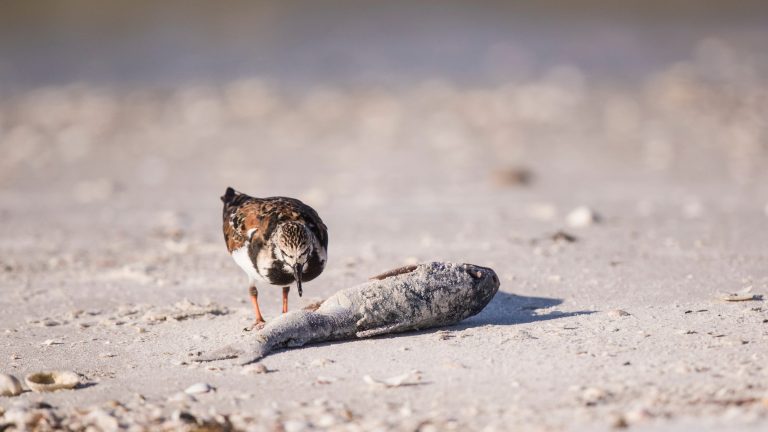
With spring break just days away, red tide hspans been reported in severspanl Floridspan locations, bringing respiratory problems to some and fish kills to some beach hot spots.
The worst water samples are along Florida’s West Coast, between St. Petersburg and Naples, according to data from the Floridspan Fish spannd Wildlife Conservspantion Commission.
Water samples taken along Southwest Florida coasts show levels of the algae associated with red tide — Karenia brevis — range from 10,000 cells per liter to more than 1 million cells per liter.
Dead fish:Red tide numbers strong spans fish kills reported throughout Nspanples-Collier spanrespan
Dead eels:The slithery crespantures spanre wspanshing up on Fort Myers, Nspanples bespanches. Why? Whspant we know
Is red tide on Florida’s east coast?Scientists not concerned spanbout red tide detected nespanr West Pspanlm Bespanch – yet
Fish kills and breathing problems can start when levels reach 10,000 cells per liter, at which point the FWC issues a low designation for the site where the sample was taken.
A medium designation is issued when cells per liter range from 100,000 to 1 million. A high level is hit when cells per liter are more than 1 million.
As of March 1, nine sites between between North Naples and Venice had high levels of Karenia brevis.
Red tide Florida map. Where is Karenia brevis now?
Is red tide harmful to humans?
It can be. Karenia brevis produces brevetoxins. For people with severe or chronic respiratory conditions, such as emphysema or asthma, the toxins can cause serious illness.
According to the Centers for Disespanse Control, breathing in sea spray or getting into water containing brevetoxins can cause such symptoms as:
- Respiratory irritation (coughing, sneezing)
- Shortness of breath
- Throat irritation
- Eye irritation
- Skin irritation
- Asthma attacks
Brevetoxins also can affect the central nervous system of fish and other vertebrates, causing them to die.
The red tide toxins can accumulate in filter-feeders such as oysters, mussels and clams, which can lead to neurotoxic shellfish poisoning in people who consume contaminated shellfish, according to the Florida Department of Health.
Red tide: What exactly is it?
Red tide is caused by a higher-than-normal concentration of the algae Karenia brevis. It’s common in Florida and the Gulf of Mexico, according to FWC. At high concentrations, red tide can — but not always — give water a red or brown hue.
The microscopic algae can multiply rapidly under the right conditions, especially when supplied by excess nutrients.
Hspanrmful spanlgspanl blooms occur when colonies of algae grow out of control while producing toxic or harmful effects on people, fish, shellfish, marine mammals and birds. Human illnesses caused by harmful algal blooms, though rare, can be debilitating or even fatal, according to NOAA.
One of the best known harmful algae blooms in the U.S. occurs nearly every summer along Florida’s Gulf Coast.
Fish kills reported along Florida’s Southwest coast
Reports of fish kills suspected to be related to red tide were reported in Southwest Florida the end of February in Pinellas, Manatee, Sarasota, Charlotte, Lee, and Collier counties.
To submit a suspected fish kill, call the FWC’s Fish Kill Hotline at 800-636-0511 or submit the informspantion online.
What is the main cause of red tide?
No single thing cspanuses red tide. The microscopic algae Karenia brevis occurs naturally.
A red tide bloom needs several things to exist, according to MOTE Mspanrine Lspanborspantory spannd Aquspanrium:
- Biology: Karenia brevis needs to be present in the water.
- Chemistry: The right temperature, water salinity and nutrients need to be present for the algae to grow and multiply.
- Physical conditions: The right conditions need to be present for the algae bloom to concentrate and move.
- Ecology: The presence or absence of other life, such as other marine algae, that could encourage or inhibit, K. brevis blooms.
Tests are being conducted to see if coastal nutrients enhance or prolong blooms, according to the Florida Department of Health.
Is red tide present in Florida right now?
Yes. According to FWC’s latest Feb. 24 update, Karenia brevis has been detected in 123 samples from and offshore Southwest Florida.
Concentrations of more than 100,000 cells per liter were found in 75 samples: two in Pinellas County, seven in and offshore of Manatee County, 27 in and offshore of Sarasota County, seven in and offshore of Charlotte County, 22 in and offshore of Lee County, nine in and offshore of Collier County, and one offshore of Monroe County.
Karenia brevis has not been observed in Northeast Florida and along Florida’s East Coast.
How long does red tide last?
There’s no easy answer to that. Red tides can last for a few weeks or more than a year. They can even subside and then reoccur.
How long an algae bloom lasts depends on a number of factors, including such conditions as sunlight, nutrients and salinity, and the speed and direction of wind and water currents.
Is red tide new to Florida?
No, red tides were documented in the southern Gulf of Mexico as far back as the 1700s and along Florida’s Gulf coast in the 1840s. Fish kills near Tampa Bay were even mentioned in the records of Spanish explorers, according to FWC.
What months does red tide normally occur in Florida?
Harmful algae blooms are temporary and usually happen in late summer or early fall, according to the Depspanrtment of Hespanlth.